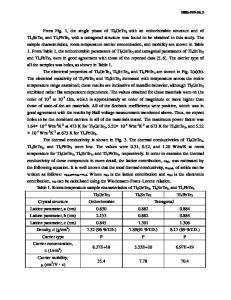High-Temperature Thermoelectric Properties of Pb 1-x Sn x Te:In
- PDF / 196,339 Bytes
- 6 Pages / 612 x 792 pts (letter) Page_size
- 31 Downloads / 312 Views
1044-U04-09
High-Temperature Thermoelectric Properties of Pb1-xSnxTe:In Vladimir Jovovic1, Suraj Joottu Thiagarajan1, Joseph P. Heremans1, Dmitry Khokhlov2, Tanya Komissarova2, and Andrei Nicorici3 1 The Ohio State University, Columbus, OH, 43210 2 Moscow State University, Moscow, 119992, Russian Federation 3 Moldova Academy of Sciences, Kishinev, 2009MD, Moldova ABSTRACT Indium in Pb1-xSnxTe alloys forms a resonant energy level in the conduction or valence bands, depending on x. In this study we investigate temperature dependence of the In level from 80 to 400K, complementing our previous work at 80 K. Measurements of electrical resistivity, thermopower, Hall and transverse Nernst-Ettinghausen effect are used to assess carrier mobility, Fermi level and scattering coefficient. Measurements are performed on a set of p and n type Pb1xSnxTe:In with 0 ≤ x ≤ 30 at% and In up to 3 at%. We show that with increasing temperature the Fermi level crosses into the gap. It had been suggested theoretically that hybridization of the In level with one band at the Fermi level could have had a positive effect on the thermoelectric properties of materials, but the present results illustrate the need for temperature-dependent modeling and experimentation. INTRODUCTION Lead telluride and its alloys with tin, Pb1-xSnxTe alloys, are classical narrow-gap semiconductors used in thermoelectric applications, particularly at x=0 and 25 at%.1 The energy gap in the ternary Pb1-xSnxTe alloys is linearly proportional to the tin concentration x. At 4K, the energy gap of PbTe is 190meV while that of pure SnTe is ~200meV,2 but with a band inversion that occurs near x=32%, where the energy gap is zero.3,4 The energy gap is also extremely temperature sensitive: above liquid nitrogen temperature it opens linearly with temperature, following a slope of 0.45meV K-1 (100 to 400K)5 practically independently of x. Several type of impurity levels are known to create resonant states with the conduction or valence bands of PbTe and Pb1-xSnxTe alloys, and have been the object of theoretical studies for over two decades, starting with Allgaier’s work.6 This theoretical work was resumed7 with the recent interest in thermoelectric applications. Indium, like several other metals, is known to pin the Fermi level in PbTe and in Pb1-xSnxTe alloys; an excellent review is provided by Kaidanov and Ravich.8 At low temperature (T
Data Loading...











